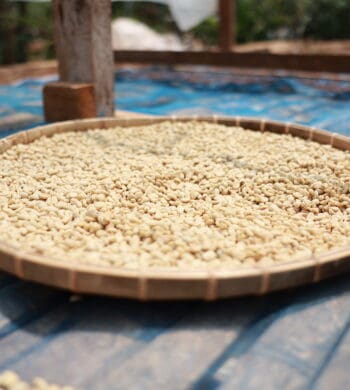Laos (or, alternatively, the Lao People’s Democratic Republic), while a relative newcomer to the specialty coffee scene, has been producing Arabica coffee since around 1920, when French colonists introduced coffee plants and the first coffee plantations were set up in the Bolaven Pleateau.
While a small (~5%) amount of coffee is cultivated in the northern provinces (Xieng Khouang, Luang Prabang, Xaysomboun, Xayabouly, Oudomxay, Huapanh, and Phongsaly), the vast majority is produced in the south, on or near the Bolaven Pleateau, which sits at 1,300 MASL, spans more than 6,000 square kilometres, and borders the Mekong river in Champasak Province. Coffee is also grown in the other southern districts of Attapeau, Saravanh, and Sekong.
The Bolaven Plateau was formerly an active volcanic region, with basalt lava eruptions from up to 16 million years ago contributing to its rich red volcanic soil today. Its climate, with plenty of rainfall between March and October, and well-marked seasons, is well-suited to growing coffee, and is host to smallholder farmers and large plantations alike.
In the Paksong District alone, there are 45,000 hectares of coffee plantations, with some especially large plantations introducing mechanical harvesting methods like those found in Brazil. But the vast majority (upwards of 80%) of coffee production comes on the Bolavens comes from smallholder farmers, many of whom have backyard gardens with no more than a few hectares of coffee shrubs. Around 40,000 families live off of coffee plantations in the Bolavens, and many communities depend on coffee to buy rice, as little is grown on the pleateau.
For Arabica production, the French colonists introduced Bourbon and Typica cultivars in plantations on the Bolaven Pleateau, particularly around Kilometre 42 near Paksong, where an agricultural research center was built.
Later, in the 1950s, Robusta and Liberia were introduced. Robusta comprises about 65% of the total coffee production in Laos, Arabica around 33%, and Liberica only 2%. Farmers will sometimes use Liberica as living fences due to its height (can grow up to 18 meters high), but isn’t significant for commercial purposes.
Unlike many other Robusta-growing coffee-producing countries, Robusta production in Laos is grown at relatively high altitudes (~1200+ MASL), leading to (in our personal experience) a much sweeter cup profile than Robustas found in other coffee-producing countries.
As a landlocked country, most coffee is exported from Laos through ports in Vietnam and Thailand. Laos is also applying to become a member of the International Coffee Organization (ICO), with aims to increase the visibility of Lao coffee and reduce it being smuggled across borders and sold without any reference to Laos.
Atlas was first introduced to Lao coffee through the USDA/Lao PDR Creating Linkages for Expanded Agricultural Networks (CLEAN) project, implemented by Winrock International, with QC training and support from the Coffee Quality Institute (CQI). Trader Susan Heller Evenson, along with two roaster clients, attended the 2023 Lao Green Coffee Competition and Awards Ceremony, where top lots scored above 86 points. Thanks to this visit and Winrock International’s efforts, Atlas was connected to a variety of producers and producer groups, and imported its first container of Lao coffee to the US in August 2023.
From experimental processed nanolots to full container commercial Robusta, conventional to Fair Trade Organic and Rainforest Alliance, Laos is producing an extensive range of coffees, and we’re looking forward to growing relationships and work to bring more Lao specialty Arabica and Robusta into the US.
